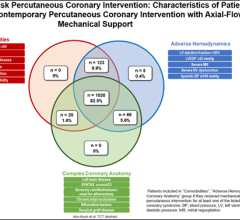October 27, 2015 — A large observational registry found that initial aortic valve replacement (AVR) in asymptomatic patients with severe aortic stenosis (AS) was associated with a lower risk of mortality and heart failure hospitalization compared with a conservative treatment strategy.
Findings from the CURRENT AS registry were reported at the 27th annual Transcatheter Cardiovascular Therapeutics (TCT) scientific symposium, sponsored by the Cardiovascular Research Foundation (CRF), Oct. 11-15 in San Francisco.
Although surgical AVR is strongly recommended in symptomatic patients with severe AS who are candidates for surgery, treatment of asymptomatic patients with severe AS remains controversial. Current guidelines generally recommend a strategy of watchful waiting for AVR until symptoms emerge in asymptomatic patients, except for those with left ventricular dysfunction, very severe AS, an abnormal exercise test or those who are candidates for other cardiac surgery. The CURRENT AS registry compared a strategy of initial AVR strategy with the conservative strategy in this population.
The CURRENT AS registry was a multicenter registry enrolling 3,815 consecutive patients with severe AS (peak aortic jet velocity >4.0 m/s, or mean aortic pressure gradient >40 mmHg, or aortic valve area <1.0 cm2). Among 1,808 asymptomatic patients, the initial AVR and conservative strategies were chosen in 291 patients and 1,517 patients, respectively. A propensity-score matched cohort of 582 patients (initial AVR group: 291 patients and conservative group: 291 patients) was developed as the main analysis set for this report. The primary outcome measures for the current analysis were all-cause death and heart failure (HF) hospitalization.
Favorable outcomes of the initial AVR strategy were seen in the analysis of the propensity-score matched cohort and the entire cohort. The effect size was smaller in the propensity-score matched cohort and, as a non-randomized study, the two comparator groups may still have had residual differences despite the use of matching.
Within the propensity-matched cohort, the cumulative five-year incidences of all-cause death and HF hospitalization were significantly lower in the initial AVR group compared with the conservative group (15.4 percent versus 26.4 percent, p=0.009, and 3.8 percent versus 19.9 percent, p<0.001, respectively). Within the entire cohort, the cumulative five-year incidence of all-cause death and HF hospitalization was also significantly lower in the initial AVR group than in the conservative group (15.4 percent versus 41.7 percent, p<0.001, and 3.8 percent versus 25.4 percent, p<0.001, respectively). The favorable effect of the initial AVR strategy relative to the conservative strategy for the clinical outcomes was similarly seen in the adjusted analysis of the entire cohort as in the propensity-score matched analysis.
Among 492 patients with emerging symptoms related to AS during follow-up, AVR was performed in 239 patients (49 percent) with median interval of 70 (IQR: 41-131) days after onset of symptoms. AVR was performed only in 74 patients (37 percent) out of 201 patients presenting with New York Heart Association (NYHA) class-3 or -4 HF. Among 127 patients who presented with NYHA class -3 or -4 HF, but did not undergo AVR, 96 patients (76 percent) died with median interval of 95 (IQR: 11-467) days after onset of symptoms.
“The CURRENT AS registry showed that outcomes might be substantially improved by the initial AVR strategy,” said lead investigator Tomohiko Taniguchi, M.D., from Kyoto University Graduate School of Medicine in Kyoto, Japan.
“Balancing the risks of the watchful waiting for aortic valve replacement and the improvement in operative mortality, AVR during the asymptomatic phase might be a viable treatment option in severe AS patients at low-risk for AVR. Further randomized controlled trials are needed to compare the two strategies,” said Taniguchi.
The CURRENT AS trial was funded by the Department of Cardiovascular Medicine, Kyoto University Graduate School of Medicine. Taniguchi reported no relevant conflicts of interest.
For more information: www.tctconference.com


 April 17, 2024
April 17, 2024 








